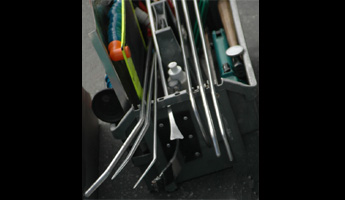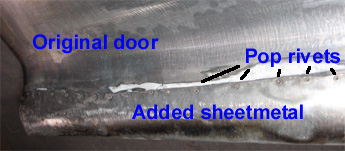|
The old saw that death and taxes are the only inevitable things in life missed one other--dents in old cars. Whether it’s tiny door dings or major prangs, unless you find that mythic perfect car, you’re sure to find dents you will need to fix.
Dents look simple, but in fact they’re always a challenge. In many cases, each dent represents a place where the car’s metal has been stretched a tiny bit. It’s not enough to pound the dent out, because that doesn’t fix the stretch and may in fact stretch it further.
Body workers use a number of techniques to work out dents, such as hammer and dolly work and hot shrinking for small dents. These work well, but require specialized skills. You can get some of these skills by taking a class at your local community college or attending a private workshop on bodywork and paint preparation. But even with proper instruction it takes a lot of practice to get good enough to work on your showpiece restoration. Top body men using classic techniques may also fill gaps with lead, which is potentially poisonous and requires even more specialized skills.
At the other end of the spectrum, you can simply fill the dent with plastic body filler (commonly known by the brand name “Bondo”), but you need to understand that no matter how good a job you do, car show judges can spot filler and will judge your car accordingly.
Bodywork is one of those areas of car restoration where you can either invest in education and practice, or you can invest in hiring a pro to do the job right. Which one is best depends on how many of these projects you expect to do and whether doing the job with your own hands is important to you.
One facet of dent removal that’s getting a lot of attention these days is paintless dent removal. This generally comes into play after your restoration is complete, such as when a tree limb falls on your perfectly restored car and dents the hood at a car show. (Don’t scoff, I was there when it happened!)
Paintless dent removal is truly an art form. The technique involves using a specialized set of tools that look like long hooks.

The hooks come in various sizes and the tips are sometimes pointed and sometimes blunt. The characteristic features are that they can be inserted behind a body panel and turned to place the tip against the backside of a dent. Once in position, the paintless dent removal artist gently massages the dent out of the metal from the backside. They often use mirrors or other devices stuck to the outside of the car to help them see the dent clearly.
A paintless dent removal must be seen in operation to be believed. The process works like magic. Slowly, patiently, working with progressively finer hooks, the dent gets smaller and smaller until you can’t tell it was ever there.
Of course, not all dents can be removed using this technique. If the paint has cracked, you’re going to be touching up the spot, or repainting the whole area. Similarly, if the metal has stretched too far, the dent cannot be massaged out, nor can the technique be used to smooth defects in which the metal is dented out from the inside. But for the vast majority of small dings, the process works well and is far less expensive than traditional bodywork.
|
 |
DO |
- Realistically assess if you can fix this dent yourself
- Get multiple estimates for the repair
- Ask your club or trusted restoration shop for recommendations
- Take a class if you want to learn to fix dents
|
 |
DON’T |
- Don’t go at it with a claw hammer and a rock covered in duct tape
- Don’t use body filler to hide more than surface imperfections
- Don’t think that you can’t learn to do this yourself
|
|
|
One of the reasons I chose the Popular Restorations feature car was because it was virtually dent free. There were several small creases on the top of the right-front fender, almost as if someone had tapped it with a long knife, and these were taken care of when the bodywork was done. However, there were other, more significant bodywork issues, notably with the bottoms of both back doors. Apparently these had rusted over the years and were repaired using patch panels, with enough putty to make it smooth.

The result was that the doors stuck out farther (at the bottom) than they should. This was corrected and is covered in the Paint and Bodywork page.
|
|
Roger Conte, Owner
Telephone: 510-895-5525
www.dentfree.us
PR: Tell us a little bit about paintless dent removal?
RC: PDR technicians use specialized tools to massage the metal back into its original form from behind the dent. Depending on the location of the damage, the panel is accessed through window openings or through other access openings. Rarely is an interior panel removed for access, which aids the speed of the process.
PR: What are the mirrors and reflectors for?
RC: The process involves being able to “read” the reflection of the dent, to see where the dent starts, where the middle is, where it ends, and then to comprehend where the tip of the tool is. We use different shaped metal rods to massage the dent out. From there it’s all skill and patience.
PR: What if the paint has cracked or chipped? That kind of puts the kibosh on the “paintless” part right?
RC: What many people perceive as a chip or scratch is often just an abrasion from the impact. If the abrasion is in the clearcoat, these can usually be polished out when we remove the dent. If the paint is chipped or scratched down to the primer or steel, then factory touch-up paint will make for a very acceptable repair. We don’t handle the touch-up, though.
PR: How much should someone expect to spend on PDR?
RC: In the industry, we talk about nickel, dime, and quarter-sized dents. Where I am in California, it’s usually about $100 to $150 for the first dent. Sometimes the first dent is so much and the second is half price. I do more of a package. So the first one is $100 to $150, but if there are a couple more, I’m already there at the customer’s home or office and can make a package price. Coin-size pricing is also dependent on the dent being basically in a flat panel that’s easy to get to. If we have to spend time to take things apart to get at the dent, that affects the price. Also, year and model matter. Some cars are easier to work with than others.
PR: As with any restoration service, we caution our readers that the cheapest price is not always the best option. Does that hold true in PDR?
RC: You get what you pay for, and experience is critical, especially when the dent falls across body lines or in challenging locations. When people are looking for a dent guy, the first thing they need to ask is “Tell me about you and your experience” - not the price. They should also ask, “Have you worked on a high-caliber car? How long have you been doing this work?”
PR: We always encourage our readers to ask for references and to rely on their local club and restoration profressionals for recommendations.
RC: That’s good. You can ask for references, but who will you get? Most of us PDR artists work a lot at used car dealerships. The reference I would give would be a restoration shop or a club, because those people love their cars.
|
| Click on any item below for more details at Amazon.com |
|

|

|
Jeffrey Zurschmeide, Russell Nyberg
Automotive Welding: A Practical Guide
S-A Design, Paperback, 2009-05-15 |
|
This book was written by our contributor, Jeff Zurschmede. Besides being informative and comprehensive it is extremely well organized and illustrated. The following topics are presented in a straightforward manner with plenty of color photos: the kinds of welding and metalworking available, the tools required to perform welding tasks, the types of welders available, basic welding techniques, grinding and cutting, various forms of sheetmetal work, frame repair and reinforcement, filling body holes and rust repair, tube-steel projects, and more.
|

|
Dennis W. Parks
The Complete Guide to Auto Body Repair
Motorbooks, Paperback, 2008-08-15 |
|
In The Complete Guide to Auto Body Repair, Dennis Parks shows you the tools, materials, and techniques that will successfully get you through the bodywork process, repairing damage from collisions, neglect, and rust.
Dennis Parks has also written How to Build a Hot Rod, How to Plate, Polish, and Chrome, How to Restore and Customize Auto Upholstery and Interiors, and How to Paint Your Car.
|

|
Eddie Paul
Sheet Metal Fabrication: Techniques and Tips for Beginners and Pros
Motorbooks, Paperback, 2008-03-15 |
|
In this book, Eddie Paul gives readers the means to mold their own sheet metal creations. Topic covered include the necessary tools and how to use them; how to choose, prepare and work with the right material; how to make forms and mock-ups, and much more.
|

|
Martin Thaddeus
How to Restore Classic Car Bodywork
Veloce Publishing, Paperback, 2004-09-27 |
|
This book goes into detail about all facets of body and frame metalwork, with detailed, photo-rich procedures for such tasks as wheel arch and door sill repair. Hammer and dolly, pick and file techniques are explained and illustrated. This book does not cover paint prep or mechanical issues - this is strictly “panel beating.” This book was written and published in Britain for a British audience, but is perfectly applicable to American restorations.
|

|
Key To Metal Bumping Book
|
|
Published over 50 years ago, it’s still one of the best basic reference books. Shows how to inspect damage to determine stress areas, and how to unlock the crease with appropriate hammer and dolly technique. Over 120 pages showing many repairs on vintage vehicles.
|

|
DENT OUT CROSS BAR Ding Repair Kit
Dent Out Cross Bar Ding Repair Kit
|
|
This kit provides the do-it-your-selfer with an option to expensive dent removal services. No need to access the underside of the panel. You apply a bead of glue to the pulling nib and affix the nib to the lowest area of the dent. A wing nut tool is threaded down and that pulls the metal up. A release agent is applied to the glue and the pulling nib comes right off.
|

|
Tool Aid
Tool Aid 81200 Midi-Weight Slide Hammer Dent Puller
|
|
This slide hammer comes with a 5lb. slide weight on a plated, solid, 5/8” shaft. The soft cushion vinyl grip absorbs shock. Suitable for pulling out curled and creased edges and panels. Helps in aligning hood and trunk hinges.
|

|
Lock Technology
Paintless Dent Removal Kit
|
|
As paintless dent removal sets go, this one is affordable and easy to master. Thirteen interchangeable stainless and plastic tips with swivel head action replace over 100 obsolete paintless dent removal tools. Magnetic reflector board and training DVD are included.
|
|
|
|